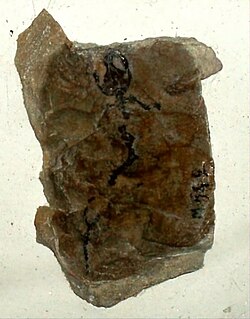| Pietraroja Plattenkalk | |
|---|---|
| Stratigraphic range: Albian ~ | |
 The village of Pietraroja with, immediately above it, the Le Cavere quarry, where the Pietraroja Plattenkalk outcrops | |
| Type | Geological formation |
| Lithology | |
| Primary | Limestone |
| Location | |
| Coordinates | 41°18′N14°30′E / 41.3°N 14.5°E |
| Approximate paleocoordinates | 23°30′N16°12′E / 23.5°N 16.2°E |
| Region | Campania |
| Country | Italy |
| Type section | |
| Named for | Pietraroja |
The Pietraroia Plattenkalk is a Cretaceous geologic formation located in the Italian municipality of Pietraroja, [1] near Benevento, in Campania region. It is of Albian age. Dinosaur remains diagnostic to the genus level are among the fossils that have been recovered from the formation [2] and the type locality of the formation is the La Cavere quarry, which is near the village of Pietraroja.










